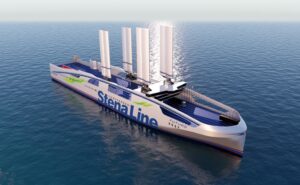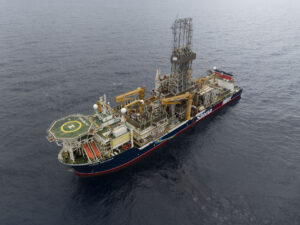Keel laid for Stena Line’s final two E-Flexers
The has been laid for two E-Flexer ferries being built in China for Swedish ferry company Stena Line and its sister company Stena RoRo.

The keel laying ceremony took place at the CMI Jinling Weihai Shipyard on 14 October, Stena Line said on social media.
The two 240-metre-long newbuilds are scheduled for delivery in 2022.
The ships are the final two of five E-Flexers that Stena Line ordered from Stena RoRo in 2018. Their construction began at the abovementioned shipyard earlier this year.
Related Article
Stena Estrid and Stena Edda, the first two E-Flexers, already entered service on the Irish Sea earlier this year. The third vessel, Stena Embla, is expected to go in to service on the Belfast-Liverpool route in early 2021. All five vessels will be delivered gas-ready to allow conversion to methanol or LNG fuel.
Once completed, the final two ferries from the batch will have a load capacity of 3,600 length metres, compared to the first three which are 214 metres long and have a load capacity of 3,100 length meters. In total, the larger vessels also get 50 per cent more cabins and beds, 30 per cent increased passenger capacity and an additional 15 per cent cargo capacity.
Stena Line boosts presence in the Baltic Sea
Separately, Stena Line today announced an expansion and strengthening of its operations across the Baltic Sea region.
Next year, the current vessels on the Nynäshamn-Ventspils route will be replaced with two lengthened RoPax ferries Stena Lagan and Stena Mersey, which will add further 30 per cent freight capacity. The new ferries will also offer an attractive alternative way to travel on the Baltic Sea.
The move is expected to increase freight capacity by almost a third, according to Stena.
The company has eighteen ferry routes in Europe. Three of them are operating across the Baltic Sea. Since Stena Line acquired the ferry route between Nynäshamn in Sweden and Ventspils in Latvia in 2012, it has more than doubled its operations from one vessel and 10 departures per week, to the current fixed timetable, which has two vessels and 24 departures per week.
“We have seen an increase in demand from our customers across the wider Baltic Sea region. We are now strengthening our position and customer offer further with new … vessels and more capacity,” Niclas Mårtensson, CEO Stena Line, explained.
Lengthened vessels from the Irish Sea
The two RoPax vessels Stena Lagan and Stena Mersey were built at the Italian shipyard Visentini in 2005 and have been operating on Stena Line’s Irish Sea route between Belfast and Liverpool for the last 10 years.
The two vessels will be upgraded, modified and lengthened before returning to Stena Line to operate on the Nynäshamn-Ventspils route from 2021. The conversion is conducted by Stena RoRo and Sedef Shipyard in Turkey.
Specifically, the ship pair will be lengthened with a 36 metres mid-section and after the conversion they will be 222 metres long, with a capacity of 200 cabins, 970 passengers and 2,875 freight lane meters plus the additional car deck; adding another 30 per cent freight capacity on the route.
To increase the loading efficiency they will also be modified with drive through capabilities on two levels. The vessels will also be fitted with hybrid scrubbers, Stena continued.
The first of the two vessels, Stena Lagan, is currently at the Sedef Shipyard in Tuzla, where it is planned to start operating on the Nynäshamn-Ventspils route in the beginning of 2021.

Stena Mersey is still operating on the Belfast-Liverpool route and will be replaced by the third E-Flexer Stena Embla in January 2021 before leaving for its lengthening at the Sedef Shipyard. It is expected to return to service on her new route later during the year.








